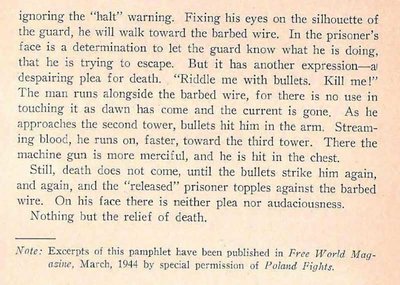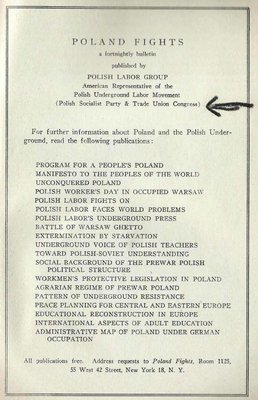The second publication was also produced in 1942 in the PPS WRN book "Obóz śmierci" ("Camp of death") written by Natalia Zarembina.[26]
Polish reports about Auschwitz were also published in English versions. A booklet titled Zarembina was translated into English and published by the Polish Labor Group in New York in March 1944 with the title "Oswiecim, Camp of Death (Underground Report)" with a foreword by Florence Jaffray Harriman. In this report from 1942, the gassing of prisoners was described.[28]
Link: https://archive.org/details/OswiecimCampOfDeath
I finally got around to taking a look at it yesterday. Based on the title "Camp of Death" and the mention of gassing, you might expect it to be a pretty typical holocaust tale. To the contrary, I found the actual content to contradict the Auschwitz legend. And not on minor points like it says 3 columns instead of 4 and that sort of thing. Rather, the contradictions are fundamental and substantial.
The Opening Sentences
OSWIECIM concentration camp, Ausschwitz in German, has for two years symbolized the sinister reality of Polish life under German occupation. The shadow of Oswiecim falls over the whole of Poland, for the most remote corners of the country have yielded their sons and daughters to its torture chambers.
Ok, sounding pretty "holocausty" so far...
According to verified information up to July 1942, 125,000 persons passed through the camp, while, during all of the camp's existence, barely 7,000 persons have been released. This figure includes twelve persons who escaped or who were transferred to other camps. At that time 24,000 men and women remained alive. Consequently, 94,000 people have perished in Oswiecim.
Wait a minute. Only 94,000 deaths through July 1942? They'd better get cracking if they're going to hit a million by the end of 1944. [The deaths in 1942 were probably around 45,000 "normal" deaths. As of July it should have been maybe 20-25,000. Plus maybe another 10,000 for previous years.]
In addition to Oswiecim, there are a series of other camps, organized somewhat later: Tremblinka, Belzec, and others in the past year in almost every administrative district. Life in any of these camps is an inferno equal to that of Oswiecim. However, in Oswiecim, the methods of cruelty have been lowered to their vilest depth, and applied in every form.
As this was originally written in 1942, this would have been the peak killing time of the Reinhardt camps yet here it's suggested that if anything Oswiecim is the worst.
For a long time, complete secrecy shrouded the sufferings in the camp. He who fell into its net kept its dreadful secrets with him until his death...Though the Germans wished to hide their crimes completely news began to leak out of Oswiecim, At first there were rumors, then more factual news, until the full secret of the camp was revealed.
The Gassing Account
Actually, the penal barrack is a double building, connected by a wall, which is the major deviation from the general architecture of the camp. The second is the row of tiny windows, set just above the foundation, that look out on the world with a gloomy, mysterious appearance. They are the eyes of the underground, dark cells from which one never returns.
On one particular day, there is unusual activity in the penal barrack, for it is moving day. The entire penal group, about 300 men, is being moved upstairs in the neighboring, newly-built block. Serious cases are being taken to the hospital. There are many guesses about what is happening, from the hospital being expanded to the complaint that "it's about time because it is over-crowded." The bustle around the barrack continues into the night, but all one can hear is the crunching of feet on the gravel, and the sounds of steps filtering down and vanishing into the basement: a new detachment of prisoners, 500 Russians. Thus, in addition to its Polish backbone, Oswiecim has appendages — Czechs, Germans, Jews, Serbs, and now Russians.
The question is why these last should be placed with the gravely ill, for they cannot be sick if they came in by their own strength. No prisoner in the other barracks tries to sleep, for all listen to what is happening in the suddenly emptied and as suddenly refilled penal barrack.
There is a brief pause between the sounds of shuffling feet and the outbreak of inhuman cries that penetrate into the night from out of the tightly closed windows. There is fear in the cries, but the ears of listening prisoners, well-versed in the art, can distinguish the cries of pain from those of fear, and from those of despairing resignation. The performance is repeated several times and the crescendo of cries rises. Then there is silence, an ominous silence that spreads around the double barrack. In the ensuing daylight, the silent barrack seems like a huge slab over an immense grave.
For three days, nothing breaks the silence of the barrack. The fourth night, the gravel again crunches under the pressure of wheels. Trucks drive up to the barrack to remove the clothing that had recently been on seriously ill Polish prisoners brought to the hospital, and those taken from the Russian prisoners-of-war. The camp suits and the uniforms are sent to the camp warehouses. Soon, the load changes to naked bodies piled high between the sides of the carts that, beyond the gate, move toward the crematorium.
It is a five-minute walk from the camp yard to the crematorium, but the prisoners pushing the cars are in even a greater hurry to discharge their burdens. But the work goes on for a long time in the task of shifting the "loads" from the penal barrack to the red chimney.
The feeble moonlight is a ghastly spotlight for the piles of stiffened features and livid flesh. One cart, unevenly loaded, overturns, and, for a minute, the corpses seem to regain life as they leap over one another and roll down the embankment, waving their stiffened arms, coming to rest in a scattered mass. The "prisoner ghouls" work feverishly to reload the cart in the fast waning darkness of the night. Before they finish, sudden dawn brings out the strange, greenish pallor of the dead. One prisoner, who has grabbed a corpse by the arm, stops suddenly and stares for a long time into its face. Years ago he had seen another like it, in an abandoned trench, with the same spectral appearance.
It is the mark of poison gas.
No one emerges alive from the darkness of the underground cells to tell a word, and yet, in the first bit of dawn, the secret of 800 dead men filters through. A trip to Oswiecim, a flight of steps into the "underground” and death by gas.
Wikipedia carefully describes this as "gassing of prisoners." Most Wikipedia readers will subconsciously substitute "Jews" for "prisoners" in that sentence. But the actual text here makes it clear that Auschwitz was not thought of as a "Jewish" camp and there is no implication that Jews are singled out for gassing. It's also notable that the gassing rumors appear to have been around before Jews started featuring Auschwitz in their extermination claims. Amusingly, the account claims no direct evidence for gassing. Rather, the prisoners "discovered" this by performing a visual autopsy of sorts on a corpse on the way to the crematory
There is also an appendix with intel on the concentration camps (much of it accurate). The whole thing is worth a look, but I will just highlight the big one.
Concentration Camps for Jews
Those camps have been established in conjunction with the Nazi campaign to liquidate the European Jews. Some of them are simply places of execution where Jews from Poland and the rest of Europe are asphyxiated, electrocuted, and machine-gunned.
The most notorious of these are:
Belzec
Sobibor, near Wlodawa
Tremblinka III
Six other camps for Jews are located in :
Starogard II
Potulice III
Kosow Podlaski
Trawniki
Pomiechowek II
Between Chelm and Wlodawa (the name could not be ascertained)
In these camps, too, the Jews are murdered, but mostly by starvation, disease, torture, and forced labor.
The methods of execution listed here are one problem. But the really big problem is that this writer of a booklet describing the horrors of Auschwitz seems to have no idea that Auschwitz is supposed to play an starring role in the supposed Jewish extermination. Consider that a few months after this was published in America the Auschwitz protocols were making the rounds saying 1.7 million Jews gassed at Auschwitz. The incongruity is jarring. This goes back to an observation Butz made in Hoax. Auschwitz was not incorporated into the extermination claims until relatively late in the war yet then went on to be the centerpiece of the Holocaust.
The only way the hoaxers can try to save this is to say that this booklet was based on information through mid 1942, but the industrial slaughter didn't "really" get going until perhaps early 1943. Okay, go ahead and try to thread that needle if you want. I DON'T BUY IT. The problem remains that we already have the Polish underground calling Auschwitz a "camp of death" and passing around gassing stories in mid 1942 and yet it clearly was not a Jewish extermination camp. Which is more likely: The Germans transformed it into a Jewish extermination camp right after the ink was dry on this report? Or, Jews transformed it into a Jewish extermination camp in the popular imagination?






